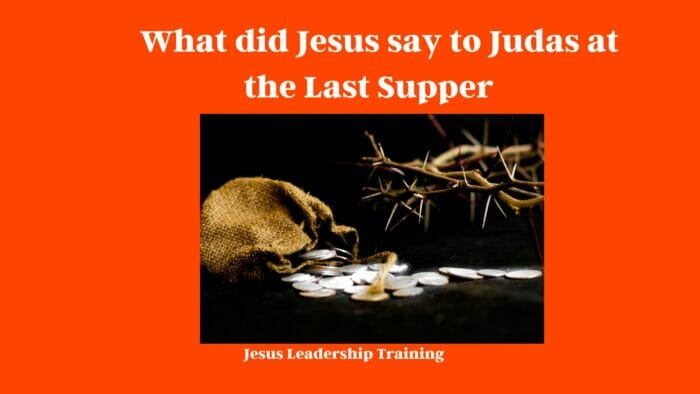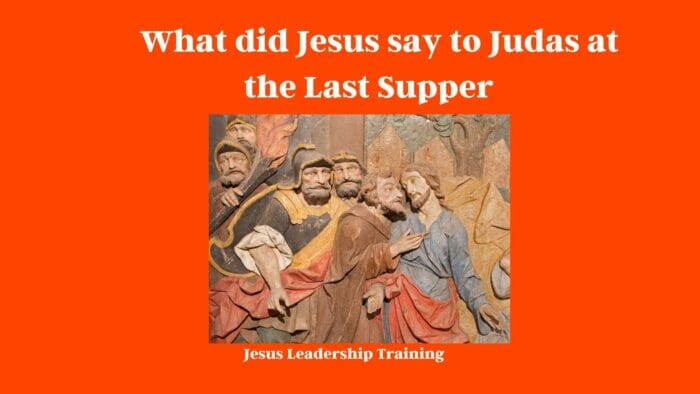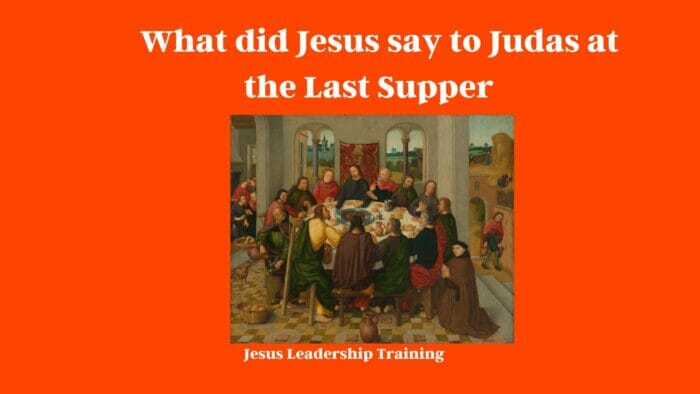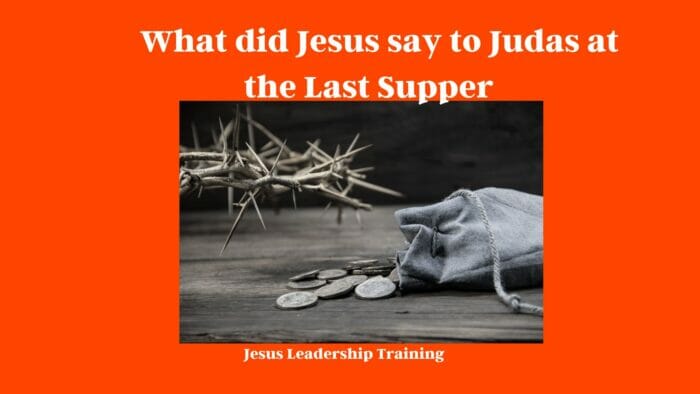What did Jesus say to Judas at the Last Supper – At the Last Supper, Jesus said many things to his disciples, including Judas Iscariot. The most famous of these words was when Jesus gave Judas the bread, saying “What you are about to do, do quickly,” which Judas took as a sign to go betray Jesus. Additionally, Jesus also said, “Friend, do what you came for,” in reference to Judas’ mission to betray Jesus.
Table of Contents
What did Jesus say to Judas at the Last Supper?
The Last Supper is a significant event in the Bible, and one that has been featured in numerous works of art throughout the centuries. It is often used to represent the unity and love of Jesus and His disciples, and the importance of the Eucharist. But there is one moment in the Last Supper that has remained largely shrouded in mystery: the conversation between Jesus and Judas. What did Jesus say to Judas at the Last Supper? It is a question that has been asked for centuries, and one that continues to elicit debate and speculation. In this blog, we will explore the various accounts of the Last Supper and examine the possible answers to this question.

What Jesus Understood about Judas Actions
- John 13:2 – “And supper being ended, the devil having already put it into the heart of Judas Iscariot, Simon’s son, to betray him.”
Jesus was aware of the devil’s influence in Judas’ actions and that he would ultimately betray Him. - John 13:27 – “After the piece of bread, Satan entered into him.”
Jesus understood that Satan had taken hold of Judas and was influencing his decisions. - John 17:12 – “While I was with them, I kept them in thy name: those that thou gavest me I have kept, and none of them is lost, but the son of perdition; that the scripture might be fulfilled.”
Jesus knew that Judas was the one who would be lost, and that this was part of God’s plan. - Matthew 26:21-22 – “And as they did eat, he said, Verily I say unto you, that one of you shall betray me. And they were exceeding sorrowful, and began every one of them to say unto him, Lord, is it I?”
Jesus showed that he understood that one of the disciples would betray him, and even asked them if it was them. - Luke 22:3 – “Then entered Satan into Judas surnamed Iscariot, being of the number of the twelve.”
Jesus understood that Satan had entered Judas and was influencing his actions.

Detailed Description of Judas Betrayal of Jesus
The betrayal of Jesus by Judas has been a major part of Christian history for centuries. It is one of the most dramatic moments in the life of Jesus, and has been captured in many works of art and literature. However, it is not always easy to understand the full implications of this event. What was the real reason for Judas’ betrayal of Jesus? What were the motivations behind his actions? How did this act of treachery shape the life and ministry of Jesus? In this blog, we will explore these questions in greater detail to gain a better understanding of this pivotal moment in the life of Jesus.
The Bible provides some insight into the reasons for Judas’ betrayal. According to the Gospels, Judas was motivated by money, and he accepted a bribe from the chief priests in exchange for betraying Jesus. Additionally, it is suggested that Judas felt envy or resentment towards Jesus and his disciples, or that he was jealous of the attention and recognition Jesus was receiving from the people.
The consequences of Judas’ betrayal were far-reaching. Judas’ actions led to the death of Jesus, which was the ultimate sacrifice for the sins of humankind. In addition to the immediate consequences of Judas’ actions, it is thought that his betrayal had long-term implications for the early Christian community. It has been suggested that Judas’ betrayal created a rift between Jesus and his disciples, and caused them to be more suspicious of outsiders. It also caused a shift in the power dynamics of the early church, as the chief priests and the Romans were seen as the new authorities.
The betrayal of Jesus by Judas shows us the power of sin, and how it can bring about devastating consequences. The story of Judas’ betrayal is a sobering reminder of how a seemingly small act can have far-reaching implications. It is a powerful warning to us all to be mindful of our actions, and to strive to follow the path of righteousness.
Judas’ betrayal of Jesus was a pivotal moment in Christian history. It not only led to the death of Jesus, but also had long-term implications for the early church. It is a powerful reminder of the destructive power of sin, and how our actions can have far-reaching consequences. It is also a reminder to us all to be mindful of our actions and to strive to follow the path of righteousness.
Possible Motives that Judas Displayed in Betraying Jesus
- Greed: Matthew 26:14-16 records Judas’s agreement with the chief priests to betray Jesus in exchange for thirty pieces of silver. This suggests that Judas was motivated by a greed for money and material possessions.
- Jealousy: Luke 22:3 reports that Satan entered Judas as he approached Jesus in the Garden of Gethsemane. It is possible that Judas’s envy of Jesus’s popularity and power drove him to betray Jesus.
- Frustration: John 6:70 tells us that Judas was one of the twelve disciples that Jesus chose to be with him. Even though he was chosen, Judas may have felt overlooked and frustrated by Jesus’s leadership.
- Fear: Matthew 26:75 records that Judas was so overwhelmed by guilt after his betrayal that he committed suicide. Judas may have been motivated by a fear of punishment or retribution from Jesus or the other disciples.

How Judas Showed his Remorse in Betraying Jesus
- Matthew 26:75: Immediately after Judas betrayed Jesus, he was filled with remorse, and he went to the chief priests and elders of the people to return the thirty pieces of silver he had been paid for betraying Jesus. “I have sinned,” Judas said, “for I have betrayed innocent blood.” Judas’s deep remorse over his betrayal of Jesus was evident in his words and actions.
- Matthew 27:3-5: Judas was so filled with remorse and guilt over his betrayal of Jesus that he went and threw the thirty pieces of silver at the feet of the chief priests and elders of the people. He then left the temple and went and hanged himself. Judas’s extreme reaction of guilt and despair over his betrayal of Jesus was a clear sign of his remorse.
- Acts 1:18-19: Judas’s remorse for betraying Jesus was also evident in his death. After he had thrown the thirty pieces of silver at the feet of the chief priests and elders of the people, he went and hanged himself. His suicide was a clear sign of his guilt and remorse for his actions.
- Luke 22:48-50: Judas’s remorse for his betrayal of Jesus was also evident in his words. When Jesus was arrested, Judas stepped forward and said, “Surely it is I, Lord.” When Jesus replied, “You have said it,” Judas was filled with remorse and immediately went to the chief priests and elders of the people to return the thirty pieces of silver he had been paid for his betrayal. His sorrow and regret were evident in his words.
Events of Judas Betrayal
- Matthew 26:14-16: During the Last Supper, Judas agrees to betray Jesus after being approached by the chief priests, who offer him thirty pieces of silver in exchange for handing Jesus over.
- Matthew 26:47-50: Judas arrives with a crowd of people to arrest Jesus in the Garden of Gethsemane. He identifies Jesus with a kiss.
- Matthew 27:3-5: Judas confesses his betrayal and throws the thirty pieces of silver back at the chief priests. He then goes out and hangs himself.
- Matthew 27:15-26: Judas’ betrayal of Jesus is brought before the Sanhedrin and Pilate, and the people choose to release Barabbas instead of Jesus.
- Luke 22:47-48: Jesus rebukes Judas for his betrayal, saying “Woe to that man who betrays the Son of Man! It would have been better for him if he had not been born.”
- John 13:2-30: During the Last Supper, Jesus predicts Judas’ betrayal and instructs him to do what he must do quickly.
- John 18:2-12: Judas leads a crowd of people to arrest Jesus in the Garden of Gethsemane, and he identifies Jesus with a kiss.
- Acts 1:16-19: After Judas’ death, the chief priests buy a field with the money from his betrayal, calling it “the Field of Blood.”
- Revelation 17:8: Judas is described as the “unfaithful” one who betrayed Jesus.

Timeline of Jesus Relationship with Judas
- c. 26–27 AD: Jesus Calls Judas to be His Disciple – According to the Bible, Jesus called Judas to be a disciple, along with the other eleven apostles, and he became one of Jesus’ closest companions.
- c. 27–29 AD: Judas Witnesses Jesus’ Miracles and Ministry – During Jesus’ ministry, Judas witnessed several of his miracles and heard Jesus’ teachings.
- c. 29 AD: Judas Betrays Jesus – According to the Bible, Judas betrayed Jesus by handing him over to the religious authorities in exchange for 30 pieces of silver.
- c. 33 AD: Jesus Is Crucified – After Judas handed Jesus over, Jesus was tried and sentenced to death by crucifixion. Judas later regretted his betrayal and, according to the Bible, committed suicide.
- c. 33 AD: Jesus Resurrects from the Dead – According to the Bible, Jesus was resurrected from the dead three days after his crucifixion, and Judas was not present to witness it.
- c. 33 AD: Judas’ Death – According to the Bible, Judas committed suicide after his betrayal of Jesus.
Jesus’ Mission and the Last Supper
Before we can answer this question, it is important to understand the context of the Last Supper. Jesus had gathered His apostles in an upper room in Jerusalem to celebrate the Passover meal. During the meal, Jesus spoke of His mission and the importance of love, humility, and obedience. He also foretold the betrayal that was to come. In essence, He was preparing His disciples for the events that would occur in the days ahead.
What Judas Betrayal of Jesus Teaches us
- Betrayal Hurts: Judas’ betrayal of Jesus teaches us that betrayal is a painful and destructive act that can have long-lasting consequences. It is important to be loyal to those we love and to honor the commitments we make.
- Greed and Self-Interest: Judas’ decision to betray Jesus was motivated by his own greed and selfishness. This teaches us that it is important to prioritize the needs of others over our own, and to be mindful of the potential consequences of our actions.
- Forgiveness: Despite Judas’ betrayal, Jesus chose to forgive him. This teaches us that it is important to be willing to forgive those who have wronged us and to recognize that we all make mistakes.
- Unconditional Love: Jesus’ willingness to forgive Judas despite his betrayal teaches us that true love is unconditional. It is important to love others without expecting anything in return, and to accept them despite their mistakes.
- Redemption: Despite Judas’ betrayal, Jesus’ death ultimately resulted in mans redemption. This teaches us that no matter how far we have fallen, we can always be redeemed and forgiven.
Biblical Symbolism of the Last Supper
The Last Supper also had symbolic elements to it. Jesus used the bread and wine to represent His body and blood, and He commanded His disciples to celebrate the Eucharist. This was a powerful symbol of the unity and love that Jesus and His disciples shared, and it was meant to commemorate His mission on Earth.
Etymology of the Biblical Word Eucharist
The word “Eucharist” has its roots in both Hebrew and Greek. It has been used to describe the Christian sacrament of Holy Communion for centuries, and its origin and meaning have been a source of debate and conflict throughout the years. In this blog, we will explore the history and etymology of the word Eucharist, and how its origin has affected its interpretation and application throughout the years.
Origin
The origin of the word “Eucharist” can be traced back to the Greek language. The Greek word eucharistos translates to “thanksgiving” or “gratefulness” and was used to describe the Christian sacrament of Holy Communion. The word was later adopted into Church Latin and ultimately passed into the English language.
Hebrew
The Hebrew word “b’racha” is also thought to have influenced the origin of the word Eucharist. This word means “blessing” and was used to describe the Christian sacrament of Holy Communion. This interpretation is often favored by Jewish scholars, as it is believed to be the origin of the word.
Greek
The Greek word eucharistos is credited to be the origin of the word Eucharist. This word translates to “thanksgiving” or “gratefulness” and was used to describe the Christian sacrament of Holy Communion. This interpretation is often favored by Christian scholars, as it is believed to be the origin of the word.
Aramaic
The Aramaic word “Qurbana” is also thought to have influenced the origin of the word Eucharist. This word translates to “offering” or “sacrifice” and was used to describe the Christian sacrament of Holy Communion. This interpretation is often favored by scholars of early Christianity, as it is believed to be the origin of the word.
Symbolic Elements of the Last Supper
The Last Supper was also a time for Jesus to give His disciples a new commandment: love one another. This commandment was meant to represent the importance of unity and forgiveness, and it was meant to be an example of how Jesus wanted His disciples to treat each other. Jesus also used the Last Supper to symbolically wash the disciples’ feet, a gesture of humility and servitude.
Old Testament
- Bread: The bread served at the Last Supper was a symbol of the sustenance that comes from God. In the Jewish Passover meal, bread symbolized the bread that the Israelites ate when they were in the wilderness. (Exodus 16:1-36)
- Wine: Wine was a symbol of joy and abundance, as well as being associated with the divine. In the Jewish Passover meal, wine symbolized the joy of freedom from oppression. (Exodus 15:22-27)
- Salt: Salt was a symbol of a covenant, or promise, between God and his people. In the Jewish Passover meal, salt symbolized the covenant between God and Israel. (Leviticus 2:13)
- Lamb: The lamb served at the Last Supper was a symbol of Jesus, the Lamb of God. In the Jewish Passover meal, lamb symbolized the sacrifice of the Passover lamb and the ultimate sacrifice of Jesus. (Exodus 12:3-21)
- Bitter Herbs: Bitter herbs served at the Last Supper were a symbol of the bitterness of the Israelites’ slavery in Egypt. In the Jewish Passover meal, bitter herbs symbolized the bitterness of exile and suffering. (Exodus 12:8)
- Charoset: Charoset was a mixture of fruit, nuts, and spices that was served at the Last Supper. In the Jewish Passover meal, charoset symbolized the mortar used by the Israelites to build the pyramids. (Exodus 1:14)
Judas’s Remorse: A Study of the Last Supper
When we look at the Gospel accounts of the Last Supper, we see Judas’s remorse for his betrayal of Jesus. In the Gospel of John, we see that Judas was so overcome with guilt and sorrow that he left the upper room in tears. In Mark’s account, Judas is depicted as a man who was consumed with guilt and regret. It is likely that Judas was aware of the consequences of his betrayal, and he may have been looking for a way to atone for his sins.
- Judas returned the thirty pieces of silver – After his betrayal of Jesus, Judas had deep remorse and returned the thirty pieces of silver to the chief priests and elders of the Sanhedrin. This demonstrated his guilt and regret for his actions.
- He hung himself – The Bible states that Judas hanged himself out of guilt and sorrow for what he did to Jesus. This was one of the most extreme forms of remorse Judas could have displayed.
- He confessed his guilt – After his betrayal of Jesus, Judas went to the chief priests and elders of the Sanhedrin and told them what he had done. This confession was a sign of his remorse and guilt.
- He wept bitterly – In Matthew 27:3-5, it is stated that when Judas saw what he had done, he wept bitterly, which was a sign of extreme remorse.
- He returned the money to the temple – After his betrayal of Jesus, Judas attempted to return the money he received for his betrayal to the temple. This was another sign of his guilt and remorse for what he had done.
The Historical Significance of the Last Supper
The Last Supper is an important event in the Bible and one that has shaped our understanding of Christianity. It is a reminder of the power of love and forgiveness, and it is a reminder of the importance of unity. The Last Supper is also a reminder of the importance of humility and obedience. Jesus’ message of love and understanding is as relevant today as it was two thousand years ago.
An Analysis of Jesus’ Words at the Last Supper
When we look at the various accounts of the Last Supper, we see that Jesus spoke to His disciples with love and understanding. He spoke of His mission and the importance of love and obedience. He also gave His disciples a new commandment: to love one another. Jesus also offered words of comfort to Judas, and He wanted Judas to know that he was still forgiven. Jesus wanted Judas to see that there was still hope for his redemption.
- “This is my body, given for you” (Luke 22:19) – Jesus offered His body as a sacrifice for all of humanity, to pay the price for their sins.
- “This is my blood of the covenant, which is poured out for many” (Mark 14:24) – Jesus’ blood was shed to bring about a new covenant between God and mankind.
- “Do this in remembrance of me” (Luke 22:19) – Jesus asked His disciples to remember His sacrifice by celebrating the Lord’s Supper.
- “If you love me, keep my commands” (John 14:15) – Jesus asked His disciples to show their love for Him by following His instructions.
- “I am the way, the truth, and the life” (John 14:6) – Jesus declared Himself to be the only way to God and eternal life.
- “Peace I leave with you; my peace I give unto you” (John 14:27) – Jesus promised His followers that He would leave them with peace, even in the midst of their trials.
- “It is finished” (John 19:30) – Jesus declared the completion of His mission on earth.
- “Father, forgive them, for they know not what they do” (Luke 23:34) – Jesus asked the Father to forgive those who were responsible for His death.
- “Go and make disciples of all nations” (Matthew 28:19) – Jesus commanded His disciples to spread the Good News to all nations.
Examining John’s Gospel Account of the Last Supper
John’s Gospel account of the Last Supper is unique in that it offers some insight into Jesus’ conversation with Judas. According to this account, Jesus said to Judas: “Do quickly what you are going to do.” It appears that Jesus was trying to reassure Judas that he was still loved and that there was still hope for his redemption.
Matthew’s Perspective on the Last Supper
The Gospel of Matthew also offers an account of Jesus’ words to Judas at the Last Supper. According to Matthew, Jesus said: “What you are going to do, do quickly.” Again, Jesus appears to be offering words of comfort and understanding. He wanted Judas to know that he was still loved and that he could still be redeemed.
Mark’s Chapter on the Last Supper
In Mark’s chapter on the Last Supper, we are told that Jesus said to Judas: “What you are about to do, do quickly.” Once again, Jesus appears to be offering words of comfort and understanding. He wanted Judas to know that he was forgiven and that there was still hope for his redemption.
Final Thoughts – What did Jesus say to Judas at the Last Supper
A Last Supper is an important event in the Bible and one that has resonated throughout the centuries. It is a Reminder that our Sins can Have a lasting Impact on those we love. It is a reminder of the power of love and forgiveness, and it is a reminder of the importance of unity and obedience. But perhaps the most intriguing aspect of the Last Supper is the conversation between Jesus and Judas. What did Jesus say to Judas at the Last Supper? We may never know for certain, but it is likely that Jesus spoke to Judas with love and understanding. He wanted Judas to know that he was still loved and that there was still hope for his redemption.
New Testament Commentaries
Below is a table featuring some renowned New Testament commentaries, their publishers, and websites where they can be found. Please note that availability may vary and it’s always beneficial to check multiple sources for acquiring these commentaries.
| Commentary Name | Publisher | Website |
|---|---|---|
| The New International Commentary on the New Testament | Eerdmans | Eerdmans |
| Word Biblical Commentary | Zondervan | Zondervan |
| Baker Exegetical Commentary on the New Testament | Baker Academic | Baker Academic |
| The New Testament for Everyone | Westminster John Knox Press | Westminster John Knox Press |
| Tyndale New Testament Commentaries | InterVarsity Press | InterVarsity Press |
| Expositor’s Bible Commentary | Zondervan | Zondervan |
| The Anchor Yale Bible Commentary | Yale University Press | Yale University Press |




